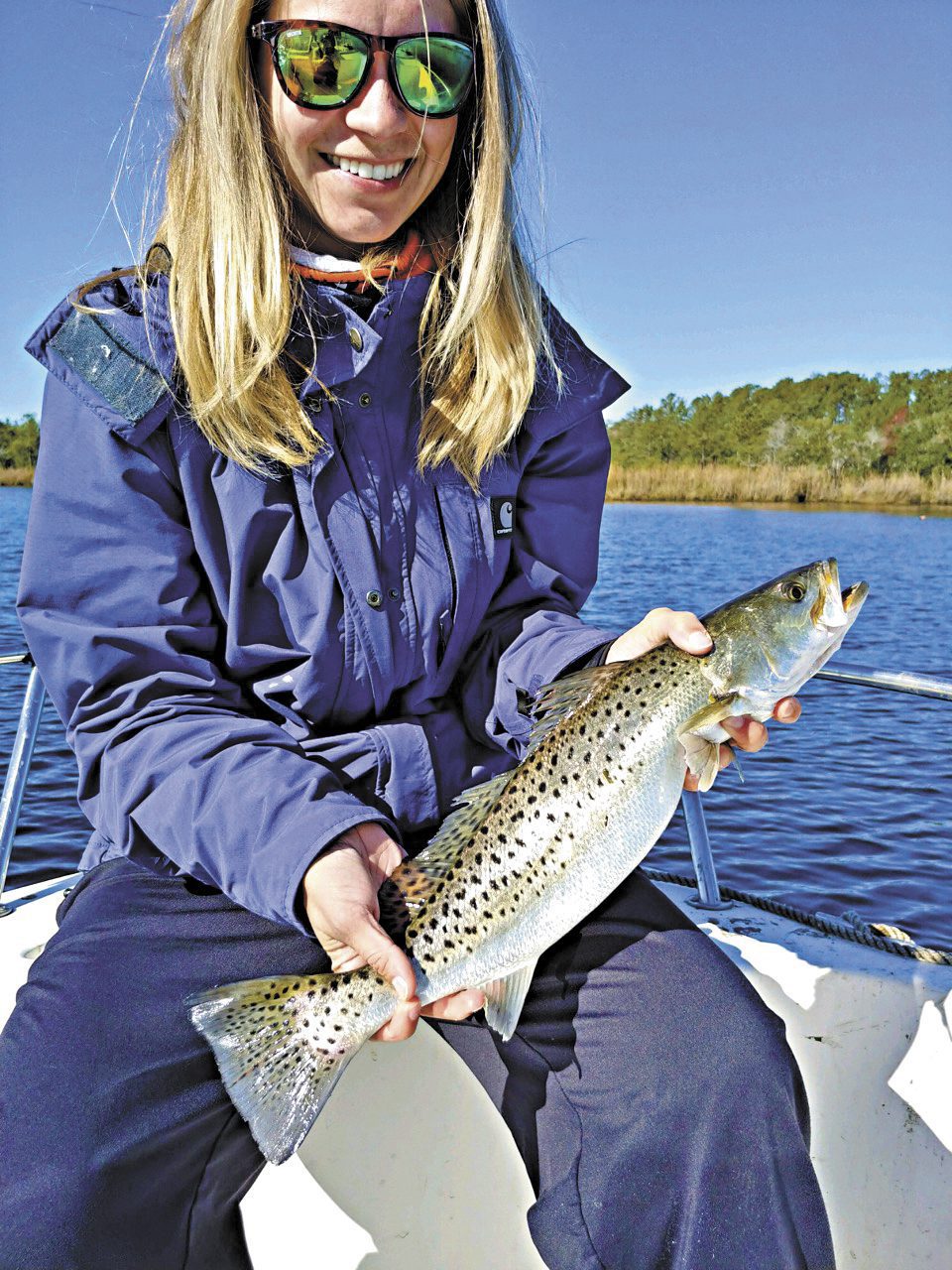Pamlico/Neuse – Winter 2019-2020
Donald, of Custom Marine Fabrication, reports that there are loads of trout in the area. Anglers are finding fish from the sound right up to the high-rise bridge in New Bern. These fish are in their mid-fall pattern and feeding on a wide variety of baits, but soft plastics and suspending lures still lead the list of local favorites. Color choices have not made much difference with the fish so active, though use of scents may be advantageous as the water temperatures begin to slow the fish down. Live mud minnows fished under corks are working great, too, and they will continue to do so through the winter.
Large striped bass are in the area and will begin to become more of a target as we move into winter. Though they are catch and release only, striped bass stay fairly active in colder water and will be staged up around structure in rivers and creeks feeding on bait left in the area.
As winter settles in, anglers will be successful in targeting speckled trout way back in creeks. Searching for deeper holes with areas of dark mud nearby is a good starting point, as these fish will move over the mud on sunny days for the little extra warmth.
Striped bass will continue to hold on structure and deeper ledges, and they’ll be hitting both soft plastics and hard lures.

Haleigh Gerlach, from New Bern, with a speckled trout caught near New Bern on a Z-Man soft plastic. She was fishing with her dad, Mike, and Capt. James Holloway, of Neuse River Adventures.
Gary, of Spec Fever Guide Service, reports that there continues to be a strong speckled trout bite through the area. These fish are starting to transition into the creeks as they prepare to stage up in their winter holes. Anglers fishing soft plastics will be more successful if they transition over to lighter jig heads to keep baits in the strike zone of the mid-lower water column longer.
A few puppy drum are mixed in these same areas, and they’re hitting soft plastics.
Striped bass are back in the creeks, with many sitting over ledges and structure. The main river also has a great class of resident fish that stay active through the winter months.
As winter settles in and the water temperatures drop, anglers will once again need to adjust tactics, especially in regards to their retrieve. The speckled trout will be extremely lethargic, and anglers will need a very slow retrieve to entice a strike. Using a light action rod is also an important key, as sometimes the bite is barely a subtle “tap.” The trout will be holed up way back in creeks in clear water over areas of dark mud, where sunny days will warm the fish.

Catie Puckett with a 20″ speckled trout that hit a Berkley swimming mullet on a jig head. She was fishing with Alex Roosen aboard the “Mr. Lazy.”
James, of Neuse River Adventures, reports that speckled trout have been biting well in the area creeks. Soft plastics fished on lighter jig heads are an angler favorite in the cooler months, with MirrOlures having great success as well. As the water temperatures drop more, targeting the far backs of creeks will be the most productive, as will fishing slow.
Striped bass are mixed in some of these similar areas, mostly located near some sort of structure. The New Bern area has a great class of resident fish that stay active all throughout the winter.
Jennings, of North State Guide Service, reports that speckled trout fishing has been the name of the game in creeks off the Neuse River. This year has been on fire in regards to the numbers and quality of fish being caught. Last year’s mild winter was great for the trout, and all anglers are hoping for another one to keep this fishery thriving.
MirrOlures have been producing best in recent days, especially with the warmer, sunny days having water temperatures creep up. Working MR17s slowly over ledges and along creek banks has been great in getting strikes. When fishing deeper holes, throwing scented soft plastics on lighter jig heads has been producing well.
Rockfish are mixed in the same bodies of water. Some anglers are having great success while trolling stick baits and divers along structure around New Bern.
Using these same methods will prove successful for anglers fishing over the next few months. Fishing slow is the main key, as the fish may be lethargic with the low water temperatures.
Todd, of Neuse River Bait and Tackle, reports that speckled trout fishing remains the hot bite in the area. Anglers are catching fish from the main river up into the mouths of corresponding creeks. These fish have slowly begun their transition into a late fall/winter pattern in which they move up the creeks in search of holes through the coldest months of the year.
Z-Man soft plastics have been the favorite. Most anglers are fishing these on lighter jig heads and (sometimes) under popping corks. Artificial shrimp have been another great choice, especially when fished under corks. Live baits and MirrOlures round out the most popular options, and as the water temperatures drop, many anglers will lean on these two choices more as they are easy options for the slow fishing required of winter trout. The use of Pro-Cure scents becomes more valuable as well, with anglers looking to entice these fish to strike.
Some good rockfish are being caught, and though they can’t be kept, it has been a wintertime staple in the region for years. Most of the stripers are still upstream with this year’s high salinity, and they will be moving into the region over the next few weeks.
After the new year, the shad begin to run up the rivers, where the stripers soon follow on their spawn. This fishery usually occurs in late February into March.
Richie, of East Side Bait and Tackle, reports that speckled trout fishing has been very good all season. As these fish move into creeks and water temperatures cool, there hasn’t been much drop-off in action. This year has seen good numbers of bigger fish, with trout to 9+ lbs. still being landed. Fishing slow has been the key in getting fish to bite.
Striped bass fishing is steady in the region, with areas of structure and ledges being the most productive areas.
Throughout the winter, anglers will need to target the backs of creeks with light soft plastics or suspending lures to get these groups of trout to strike.
Striped bass fishing, though release only, should remain steady as these fish stage up to feed on bait remaining in the area.
Mitchell, of FishIBX, reports that speckled trout fishing has been steady in the river and up into its creeks. Soft plastics have been the most effective, as anglers work ledges throughout the creeks targeting fish on their way to the back. Over the winter, paying close attention to the weather will be key in determining where these fish will be on any given day. Warmer, sunny days may have the fish moving up over muddy bottoms and flats to sun, where cooler, cloudy days may have them grouped up in deeper holes.
Puppy drum are still mixed in these same areas right alongside a few striped bass.
Over the next few months, anglers looking to target trout will be headed up creeks in search of deeper holes that will hold fish. As many hope, another mild winter would allow these fish to stay active and have another successful spawn in the spring.
Striped bass fishing is another great fishery for the area, as colder water temperatures don’t affect too much of their feeding habits. Some areas (such as the Roanoke and Pamlico) see a great run of fish over the turn of the new year when many fish will be pushing in from the sound and staging near the mouth. As February and March move in, these fish will begin to follow the bait upriver in their spawn pattern.





